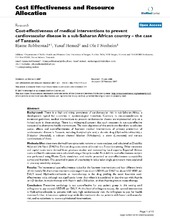| dc.description.abstract | Background: There is a high and rising prevalence of cardiovascular risk in sub-Saharan Africa, a development typical for countries in epidemiological transition. Contrary to recommendations in treatment guidelines, medical interventions to prevent cardiovascular disease are implemented only on a limited scale in these settings. There is a widespread concern that such treatment is not cost-effective compared to alternative health interventions. The main objectives of this article are therefore to calculate costs-, effects and cost-effectiveness of fourteen medical interventions of primary prevention of cardiovascular disease in Tanzania, including Acetylsalicylic acid, a diuretic drug (Hydrochlorothiazide), a β-blocker (Atenolol), a calcium channel blocker (Nifedepine), a statin (Lovastatin) and various combinations of these. Methods: Effect sizes were derived from systematic reviews or meta-analyses, and calculated as Disability Adjusted Life Years (DALYs). Data on drug costs were calibrated to a Tanzanian setting. Other recurrent and capital costs were derived from previous studies and reviewed by local experts. Expected lifetime costs and health outcomes were calculated using a life-cycle model. Probabilistic cost-effectiveness analysis was performed using Monte Carlo simulation, and results presented as cost-effectiveness acceptability curves and frontiers. The potential impacts of uncertainty in value laden single parameters were explored in one-way sensitivity analyses. Results: The incremental cost-effectiveness ratios for the fourteen interventions and four different levels of risk (totally 56 alternative interventions) ranged from about USD 85 per DALY to about USD 4589 per DALY saved. Hydrochlorothiazide as monotherapy is the drug yielding the most favorable cost-effectiveness ratio, although not significantly lower than when it is combined in duo-therapy with Aspirin or a β-blocker, in triple-therapy with Aspirin and a β-blocker, or than Aspirin given as mono-therapy. Conclusion: Preventive cardiology is not cost-effective for any patient group in this setting until willingness to pay exceeds USD 85 per DALY. At this level of willingness to pay, the optimal intervention is Hydrochlorothiazide to patients with very high cardiovascular risk. As willingness to pay for health increase further, it becomes optimal to provide this treatment also to patients with lower cardiovascular risk, and to substitute to more sophisticated interventions. | en_US |
